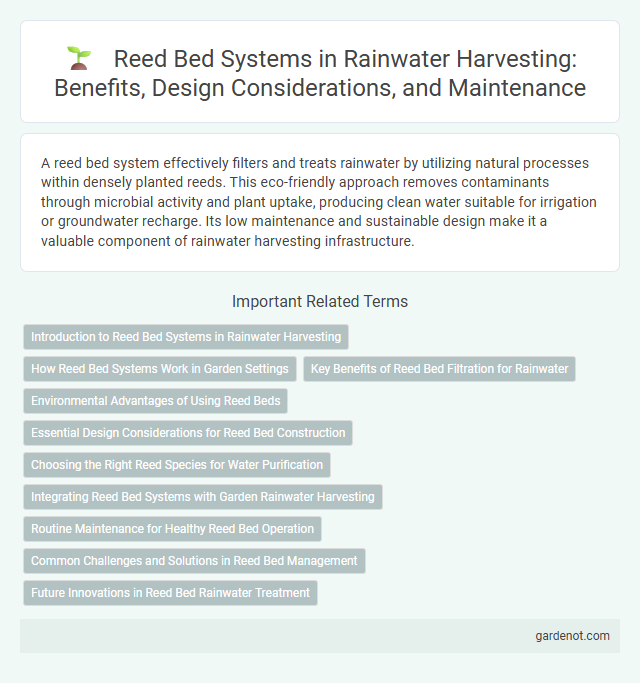A reed bed system effectively filters and treats rainwater by utilizing natural processes within densely planted reeds. This eco-friendly approach removes contaminants through microbial activity and plant uptake, producing clean water suitable for irrigation or groundwater recharge. Its low maintenance and sustainable design make it a valuable component of rainwater harvesting infrastructure.
Introduction to Reed Bed Systems in Rainwater Harvesting
Reed bed systems in rainwater harvesting utilize natural filtration by passing collected water through beds of reeds, which enhance water purification through root zone microbial activity. These systems effectively remove contaminants, nutrients, and suspended solids, improving the quality of harvested rainwater for reuse. Incorporating reed beds supports sustainable water management by combining ecological treatment with efficient rainwater storage solutions.
How Reed Bed Systems Work in Garden Settings
Reed bed systems utilize layers of gravel and aquatic plants, primarily reeds, to naturally filter rainwater collected from garden surfaces. As rainwater percolates through the beds, the roots and microbial activity break down pollutants and absorb excess nutrients, enhancing water quality before it reenters the groundwater or is reused for irrigation. This sustainable approach supports effective rainwater management and promotes a healthier garden ecosystem.
Key Benefits of Reed Bed Filtration for Rainwater
Reed bed filtration efficiently removes sediments, nutrients, and pathogens from rainwater, enhancing water quality for reuse and reducing environmental pollution. This natural treatment method supports biodiversity by providing a habitat for microorganisms that break down contaminants, promoting sustainable wastewater management. Reed bed systems require minimal maintenance and offer energy-efficient purification, making them cost-effective solutions for rainwater harvesting.
Environmental Advantages of Using Reed Beds
Reed bed systems enhance water quality by naturally filtering pollutants and heavy metals through microbial action within the root zone. These systems promote biodiversity by providing habitats for various aquatic plants, insects, and birds, contributing to ecosystem health. Their low energy requirements and minimal chemical use reduce environmental footprints compared to conventional wastewater treatment methods.
Essential Design Considerations for Reed Bed Construction
Effective reed bed system design for rainwater harvesting requires careful selection of impermeable liners to prevent seepage and contamination of groundwater. Optimal sizing based on expected water volume and retention time ensures adequate treatment through natural filtration. Incorporating appropriate plant species, specifically Phragmites australis, enhances pollutant removal and system sustainability.
Choosing the Right Reed Species for Water Purification
Selecting the appropriate reed species is crucial for the efficiency of reed bed systems in rainwater harvesting and water purification. Phragmites australis is widely favored due to its high resilience, rapid growth, and ability to absorb and filter contaminants, enhancing nutrient removal from harvested rainwater. Species adaptation to local climate and water conditions ensures optimal pollutant uptake and sustainable system performance.
Integrating Reed Bed Systems with Garden Rainwater Harvesting
Integrating reed bed systems with garden rainwater harvesting enhances natural filtration and promotes sustainable water management by utilizing plants like Phragmites australis to treat greywater and runoff. This biofiltration method reduces pollutants and nutrients before water reaches the soil or storage, improving irrigation quality and supporting plant health. Optimizing reed bed dimensions and flow rates ensures effective treatment while conserving harvested rainwater for garden use.
Routine Maintenance for Healthy Reed Bed Operation
Routine maintenance of a reed bed system for rainwater harvesting involves regular inspection and removal of accumulated debris to prevent clogging and ensure optimal water flow. Monitoring reed growth and trimming excessive vegetation promotes effective nutrient absorption and prevents system blockage. Periodic sludge removal from the sedimentation zone maintains microbial activity and supports healthy filtration, enhancing overall treatment efficiency.
Common Challenges and Solutions in Reed Bed Management
Common challenges in reed bed management for rainwater harvesting include clogging from sediment accumulation, fluctuating water levels causing root stress, and nutrient imbalances leading to poor plant growth. Solutions involve regular sediment removal, maintaining consistent water flow to support root health, and monitoring nutrient levels to optimize reed growth and filtration efficiency. Implementing adaptive maintenance schedules ensures long-term system functionality and enhances water quality outcomes.
Future Innovations in Reed Bed Rainwater Treatment
Future innovations in reed bed rainwater treatment focus on integrating smart sensors and IoT technology to optimize filtration efficiency and real-time water quality monitoring. Advanced bioengineered reed species with enhanced pollutant uptake capacity are being developed to improve contaminant removal rates. These innovations aim to create sustainable, low-maintenance systems that maximize water reuse and support urban green infrastructure.
Reed bed system Infographic

 gardenot.com
gardenot.com